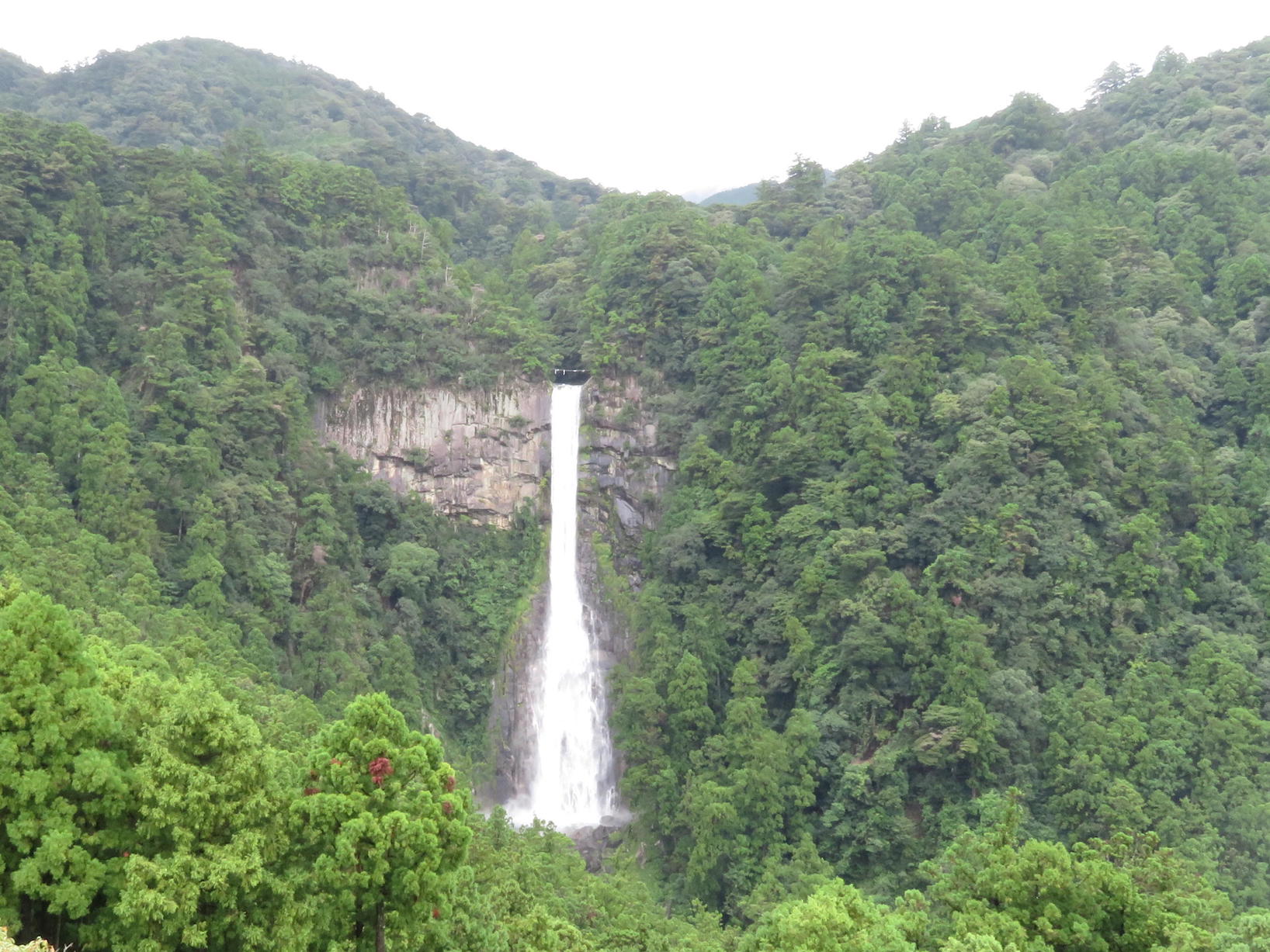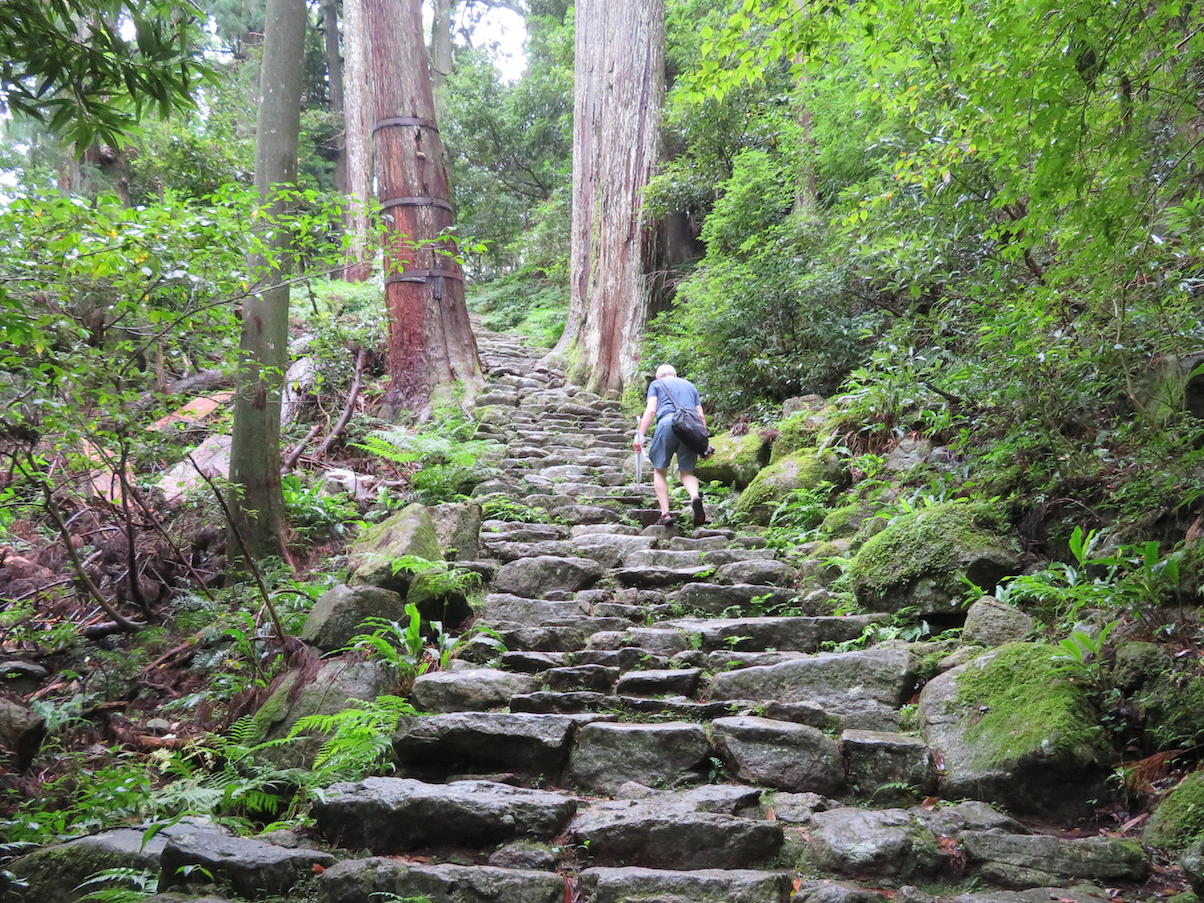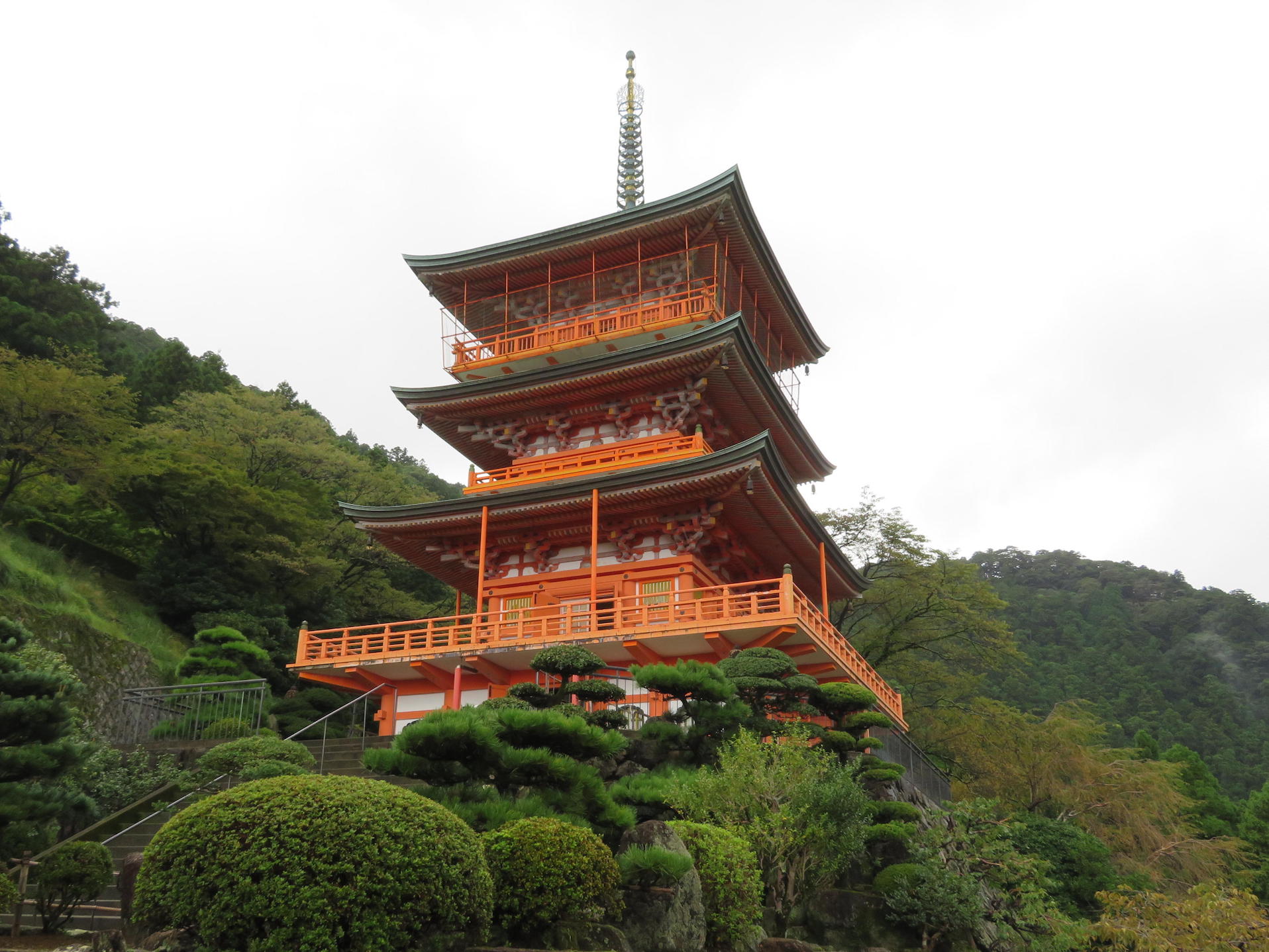… you walk up and down lots and lots and lots of steps, more than 51 floors’ worth today, in fact. This, would you believe, was our “let’s take it easy day”! Ha ha! Oh well.
Kumano Kodo
When we considered making Wakayama our main new part of Japan to visit this trip, two “sites” kept popping up in my research, the Koyasan Buddhist complex in the north, and the Kumano Kodo pilgrimage route in the south. The original site of the Hongu Taisha Grand shrine that we visited yesterday was part of this route. Koyasan and Kumano Kodo are, since July 2004, on the UNESCO World Heritage registry as “Sacred Sites and Pilgrimage Routes in the Kii Mountain Range“.
This pilgrimage has been taking place for over 1000 years. The network of routes, now called the Kumano Kodo, stretches across the mountains of the Kii Peninsula. From the very small section we did today, I reckon it would have been more than a little strenuous doing this pilgrimage. (And I reckon that some of Japanese we met today would agree!)
The bit we “did” was the Nakahechi section of the pilgrimage (according to one leaflet, though another seemed to describe Nakahechi differently.) Regardless of what it’s called, what we saw was:
- Nachi Waterfall
- Nachisan Seiganto Temple with Three-storey Pagoda
- Kumano Nachi Taisha Grand Shrine
- Daimon-zaka slope
Nachi Waterfall
This waterfall is the object of worship of Hiro-jinja Shrine, which is associated with the Kumano Nachi Taisha Grand Shrine. At 133 metres it’s the highest waterfall in Japan and is on the Nachigawa (river). Because of its spiritual status, viewing it was very different to any other waterfall viewing we’ve done. There was a little torī at one viewing area, marking it as sacred, and the red/orange lookout platform was called the “worship stage”. Using this stage cost money, but you do get to drink the water (promising longevity), using a little Y100 cup that you keep as a souvenir. It was raining in this part of the day, which added to the drama of the falls. Fortunately, the rain stopped by the time we left the falls.
Nachisan Seiganto Temple with its Three-storey Pagoda
Next stop – after a decent climb – was the Three-storey Pagoda, which also offers excellent views of the waterfall. This pagoda has a lift up the middle! Like many, many castles, temples and shrines in Japan, the original pagoda was destroyed by fire, in this instance maliciously in 1581, by an opposing family. The current pagoda was built in 1972, hence the lift! Readers, given all the steps we were doing, we used the lift!
Pagodas have to be among the most aesthetically appealing historic sites in Japan.
Next door to the pagoda is the Buddhist Nachisan Seiganto Temple, which is believed to have been founded in the early 5th century by a priest from India, though I think the current building dates to the 1580s. It looked genuinely old, its wood having that ancient weathered grey-brown look. It is closely linked to the neighbouring Kumano Nachi Taisha Grand Shrine, a Shinto institution. This close relationship between Buddhist and Shinto places is not uncommon in Japan.
Kumano Nachi Taisha Grand Shrine
Unlike the understated temple, the Kumano Nachi Grand Shrine yells out in all its red gloriousness. It is one of the three great Kumano shrines (which include yesterday’s Hongu Taisha). It is also rooted in worship of the waterfall, and in its grounds is another ancient camphor tree – remember the one on Awajijima? The tree is believed to be home to another deity. Pilgrims there today climbed up a little ladder at its base to pay their respects at a small shrine in a hollow. It’s around 850 years old, and is gorgeous. The shrine was the most buzzing place of all we visited today.
Daimon-zaka Slope
From the shrine it was a long walk back down – more steps, but regular, not cobbled ones – to the carpark area.
Anyhow, the final point of interest (though I have a nagging feeling that we did all this in the “wrong” pilgrimage order) was the Daimon-zaka (“large gate slope”) Slope. This is a 600 metre long, 267 step, cobblestone path – down all the way – flanked by centuries-old Japanese cedar trees, camphor trees and bamboo groves. Daimon-zaka means “large gate slope” referring to a gate that once stood nearby. At the bottom are two particularly old ones, the Meitosugi, or husband and wife cedar trees. I should say here that all the cobbled stone steps we walked today, although challengingly uneven, were surprisingly unslippery, despite all the dampness around. This did reduce the stress a little! We don’t want to fall! (Have I said that before?)
This walk was described as “an excellent short walk” with “manageable steps and gentle inclines”, but for Len it was not short or gentle enough, so we parted ways, agreeing that he would drive down and pick me up at the bottom! The inclines were reasonably gentle, but while the cobblestones were not slippery, they were very uneven and required a lot of care. Also, if we both went down, we would both have had to come up again (via the steps or the road) so I took one for the team! Or maybe, depending on your point of view, it’s Len who did!
Costs
Now a bit about money! Both at the Tanize Suspension Bridge yesterday, and today, we were directed into a parking space at the site, and paid Y500 for the pleasure. We also paid, today, Y300 each to go to the waterfall “worship stage”; Y100 for the cup to use to drink the waterfall waters; and Y300 each to enter the pagoda. We could have spent more money, had we decided to carry out some of the Shinto rituals. We did do that in Awajijima, but not here.
Today’s dining pleasure
Breakfast: Our accommodation plan includes breakfast, and we opted for the 7am sitting. We arrived to find our table set with a plate containing some warm food (including a small sausage and a piece of bacon), a little two-tier holder (à la high tea) containing tiny delicacies, a basket with two bread rolls and two croissants. Then there was the buffet with rice, salad items, and a chef making omelet to order. Needless to say we couldn’t eat all of this, and we disappointed them, rather, that we didn’t want an omelet. Even though half of the offering was not suitable for me, there was still more than I needed. Tomorrow, we do it all again …
Lunch: We had hoped to find a little place in a sea-side village – the dreams of the traveller – but we hunted in vain, and ended up at a place called Shippo (by the sea in fact) very near our hotel. It seemed to be a multi-generational family run place, and was clearly music focused. There was a little stage area at one end with musical instruments, and our lunchtime music (not live) was jazz (Louis Armstrong, and the like). I loved my Tuna sashimi set. It was a good lunch-size serving. Len had a katsu-don, which he also enjoyed.
Dinner: Another adventure, as finding dining places often are in Japan. We had chosen an izakaya (Japanese pub) but then decided to go to the one recommended by the hotel staff. We also decided to walk. Well, the recommended one was closed or we didn’t find it, so we decided to go on to our first choice which involved an extra long walk as it was in a different direction to the first one. We got there, to find it open, but empty. Unlike Shippo, but not uncommon for izakayas, it had no English menu. However, between the owner’s limited English and our limited Japanese, we managed to identify and order some dishes. He was watching the World Cup, and we encouraged him to un-mute the sound as we didn’t mind.
While we were eating and drinking, an English-speaking couple turned up, and I was sure they were the couple we saw checking in at our hotel as we’d set off. And so it turned out to be. They were Kiwis who live in Perth, and we whiled away a couple of hours talking Japan travel experiences with them, while the owner was able to enjoy the rugby, and his wife (we presume) cooked in the kitchen. (He did do all the serving.) The was a pretty typical neighbourhood izakaya – family-run with just a few tables, and a lot of knick-knacks around, as you’ll see from the photos. Nothing fancy, just your local bar serving traditional snack food (like karage, tofu, fried fish, ham katsu, and so on).
I had more observations for today … but, really, I think this is enough so will hold them over.
And some Stills…
And some Movies…
Click here to view today’s video clips
Today’s Challenges …
- Investing in, and then losing, an umbrella (by Len). That’s about AUD4 gone!
- Managing to keep in touch and meet up again, with only Len’s mobile phone and Sue’s iPad, when we separated for a while
- Drop-testing the video camera. Amazingly, it still works!
- Eventually, finding a lunch spot at 1.30pm, after a few false starts.
- Removing dozens of green stink-bugs which found their way in through the open window, because the light was left on by the good folks making up our futon bed whilst we were dining at that izakaya.





















Wonderful day ! – although more than somewhat tiring. For some reason, you seem to me to’ve had a really JAPANESE day of it.
Love that purification trough: the claws are brilliant.
The husband and wife trees – mein gott ! The very … OLDness of them. (Better word than ‘age’.)
Something I will never understand is how the Japanese can combine shinto or buddhism with so determined an intention to hunt whales – which almost none of them eat. (I shan’t get into the dolphin thing because someone will tell me that they are simply a water-animal-eating people.)
Glorious waterfall ! – I can comprehend its having a spiritual nature.
Thanks M-R, it was a very Japanese day, as you say.
Japan, like all nations I suppose, is a place of contrasts, and paradoxes. I was going to mention the whales etc in this post, but it got too long. Will probably mention it tonight.
You are introducing me to so many new places that I never visited in my 5 years in Japan. I will definitely seek these places out next time I visit Daniel. He is on the train line to Wakayama so it can’t be that far? I’m looking forward to your experiences in Koyasan. It has a reputation for being a spooky place. By the way, the handwriting for the menu at the izakaya was beautiful. The proprietor must have had many years in calligraphy I’m guessing.
I guess as tourists we are keen to explore Carolyn.
Re Koyasan, we may not make it. We should have done it on the way down to the south, but didn’t. Can’t do it all. Depends what we decide to do tomorrow.
That’s interesting re the calligraphy. We probably couldn’t tell.
Re the cost, I make that about $20 dollars, is that right? It sounds reasonable to me (if my conversions are correct, that is).
I don’t envy you those steps…
Yes, well done Lisa, that would be about right. And yes, we don’t begrudge them that.
As for the steps, wait for today’s post!!
Everything exquisitely pictured with wonderful commentary. The waterfall picture and video are wonderful. The shrines, pagoda, camphor and cedar trees are all wonderful to see – truly a feast for the eyes – peaceful and spiritual. But those steps….really….. and the cobblestones all of that seems quite the chore. Is making it difficult and uncomfortable to get to part of the “spiritual beauty of it all”? I guess so. I mean people should be impressed when they hear you walked up to the pagoda and shrines, actually the path down didn’t look like a picnic either. But it was aesthetically all very pleasing to see just painful and tiring to think about. It sounds like you used the lift to go up to the pagoda and although I did not see the lift – I LOVED the Lift! =) I guess my favorite was all the twisty turning limbs of the ancient camphor tree and the complimentary surrounding limbs. The view of the bay from your hotel is a bit magical….. and no stairs were needed.
The stone cobbles steps are so gorgeous Trudy, you are right. Stones and trees have a special place in Japan.
Sorry I can’t write more. Am in the car heading north and will soon be in new territory which will require attention.
Lovely photos and videos, thanks Sue and Len! That Nachi Waterfall and those trees are truly amazing and the cobbled stepped path of Daimon-Zaka is beautiful! The pagoda, temple and shrines are also very beautiful in design, shape and colour, and they both contrast with and fit into the landscape so well! Thank you for sharing such an evocative sense of place in this post with all these images.
We are so glad you enjoyed them Mary. I particularly thought of you when we were visiting that place.